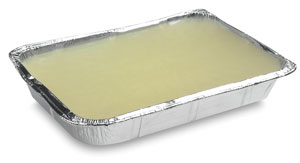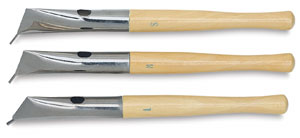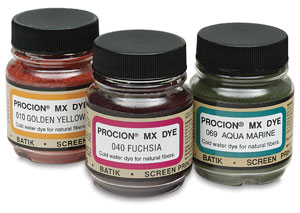premium cotton makes wax removal difficult
Hi Paula,
—ADVERTISEMENTS—

This product is a specially formulated 50/50 blend of paraffin and microcrystalline waxes. Professional quality produces the distinctive crackle effect for traditional batik.
and help support this web site
Tjanting tools
for wax application

These tools are for applying wax in fine lines. Hot wax is poured into the opening. It then flows through the needle spout. You can tip the tool forward to start the wax flow, and tip it back to stop it. Tjanting Tools come in 3 different sizes.
Buy from Blick

cool water dyes will not melt your wax
Procion dyes are permanent, colorfast, and very washable. You can easily create a palette of brilliant colors ranging from light pastels to deep, vibrant hues. Perfect for natural plant fibers - cotton, linen, paper, reeds, and wood.
Buy from Blick
and help support this web site
I read your suggestion to use Dr. Bronner's liquid castile soap in boiling water to help successfully remove batik wax from fabric.
I have learned that batiking premium cotton makes wax removal very difficult, and that bees wax tends to cling more stubbornly than paraffin. That said, I have eight lovely batik napkins that I cannot clean. The wax looks like a background shadow behind the batiked imprints. I have ironed, boiled, ironed again and boiled twice more.
How much soap per gallon should I use in the water per gallon (to try one last time to rescue my napkins?
Thank you!
Hopeful--Kathy
Hi Kathy,
When you boiled the wax out, did you let the fabric stay in the bottom of the pot (weighted down if necessary) while the water cooled enough for the wax on top to solidify? This has always seemed to me to be a key. If you lift the fabric out through the layer of liquid wax, the wax gets into the fabric again.
With the liquid Castile soap, such as Dr Bronner's, I just added a good-sized squirt from the bottle, probably between a teaspoon (5 ml) and a tablespoon (15 ml), to a gallon or two of water.
A good resource is ProChem's instructions for batik. [PDF] They say to use either a tablespoon or a teaspoon of either Synthrapol or grated Ivory bar soap; you can't really tell whether they mean a teaspoon or a tablespoon, because they say to use a tablespoon, which is 15 milliliters, but then they give the equivalent of this tablespoon as being only 5 milliliters, which is only a third as much as is in a tablespoon. I guess this implies that the exact concentration of soap or detergent is not critical.
Hi Paula,
Thanks for replying! I twice boiled the fabric and held it at. The bottom while it cooled completely.
I also rubbed ivory soap right on the offending wax. I then washed it in hot water and then boiled again. I'm wondering if there was too much beeswax and that the fabric is just too fine. I just can't seem to get the wax out of those tight fibers.
It may be that I have to give up on the napkins, and make them next time with quilter's Grade white cotton.
Thank you!
Kathy
(Please help support this web site. Thank you.)
Posted: Friday - March 22, 2013 at 09:34 AM
Follow this blog on twitter here.
Quick Links
- All About Dyes & Dyeing Top -
- Top of this blog -
- FAQ -
- The Dye Forum -
- How to Tie Dye - How to Batik -
- Books - Toys - Plants -
- Top of this blog -
- FAQ -
- The Dye Forum -
- How to Tie Dye - How to Batik -
- Books - Toys - Plants -
More in this category:
- -
Statistics
Total entries in this blog:
Total entries in this category:
Published On: Mar 22, 2013 10:39 AM
Total entries in this category:
Published On: Mar 22, 2013 10:39 AM